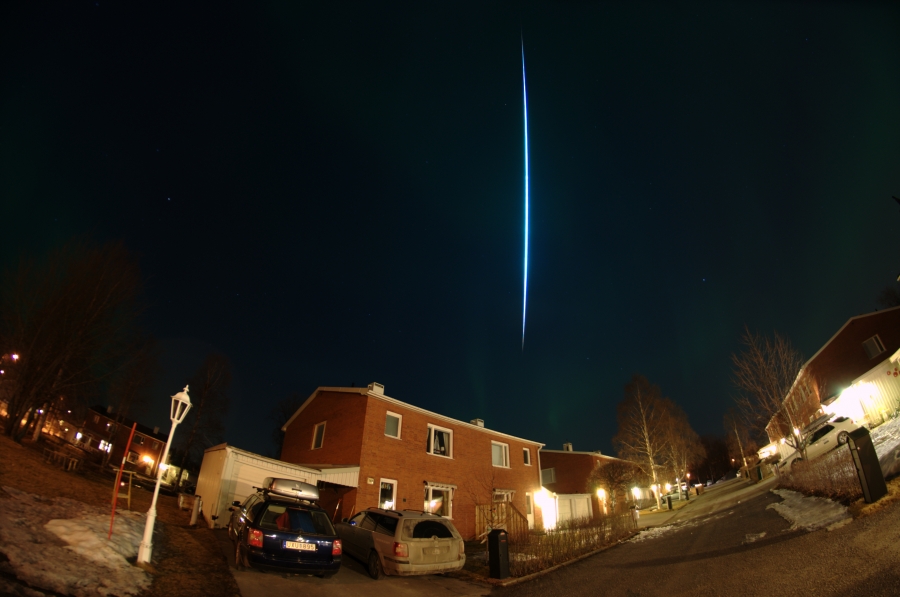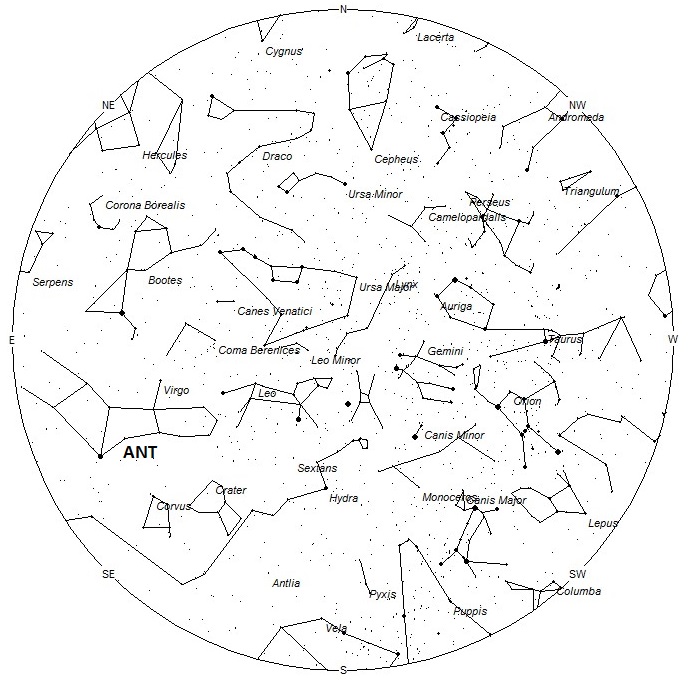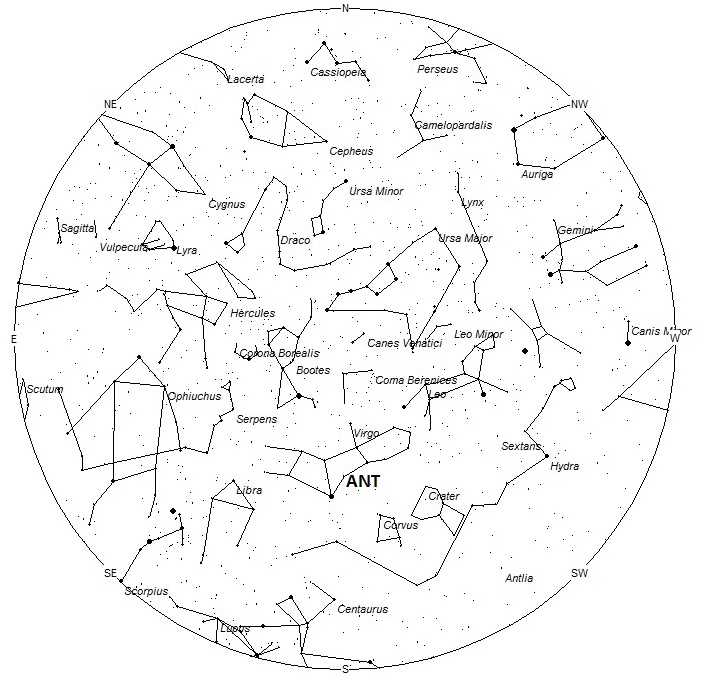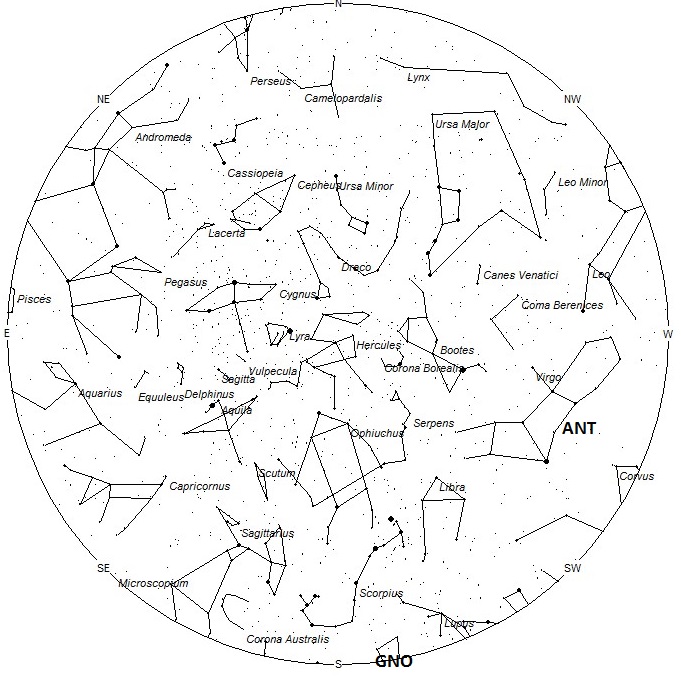
Photo shared on the American Meteor Society’s website by Jimmy Dahlström (©)
Taken from Lugnvik, Östersund, using a Nikon D300s and a Tamron 8mm lens. 30s, f3,5, ISO 200 – 2015-03-18 00:24:00
During this period the moon will reach its first quarter phase on Thursday March 26th. At this time the moon is located 90 degrees east of the sun and sets near 0100 local daylight saving time (LDT). This weekend the waxing crescent moon will enter the evening sky but will set early during the evening hours allowing unhampered views of the night sky the remainder of the night. The estimated total hourly meteor rates for evening observers this week is near 3 for observers situated at mid-northern latitudes and 4 for observers viewing from the southern tropics (latitude 25 S.). For morning observers the estimated total hourly rates should be near 7 for observers situated at mid-northern latitudes and 10 for observers viewing from the southern tropics. The actual rates will also depend on factors such as personal light and motion perception, local weather conditions, alertness and experience in watching meteor activity. Note that the hourly rates listed below are estimates as viewed from dark sky sites away from urban light sources. Observers viewing from urban areas will see less activity as only the brightest meteors will be visible from such locations.
The radiant (the area of the sky where meteors appear to shoot from) positions and rates listed below are exact for Saturday night/Sunday morning March 21/22. These positions do not change greatly day to day so the listed coordinates may be used during this entire period. Most star atlases (available at science stores and planetariums) will provide maps with grid lines of the celestial coordinates so that you may find out exactly where these positions are located in the sky. A planisphere or computer planetarium program is also useful in showing the sky at any time of night on any date of the year. Activity from each radiant is best seen when it is positioned highest in the sky, either due north or south along the meridian, depending on your latitude. It must be remembered that meteor activity is rarely seen at the radiant position. Rather they shoot outwards from the radiant so it is best to center your field of view so that the radiant lies at the edge and not the center. Viewing there will allow you to easily trace the path of each meteor back to the radiant (if it is a shower member) or in another direction if it is a sporadic. Meteor activity is not seen from radiants that are located below the horizon. The positions below are listed in a west to east manner in order of right ascension (celestial longitude). The positions listed first are located further west therefore are accessible earlier in the night while those listed further down the list rise later in the night.
These sources of meteoric activity are expected to be active this week.
The center of the large Anthelion (ANT) radiant is currently located at 12:56 (194) -06. This position lies in central Virgo, 5 degrees southwest of the famous 3rd magnitude double star known as Porrima (Gamma Virginis). Due to the large size of this radiant, Anthelion activity may also appear from Corvus, Crater, eastern Leo as well as Virgo. This radiant is best placed near 0100 LDT, when it lies on the meridian and is located highest in the sky. Rates at this time should be near 2 per hour no matter your location. With an entry velocity of 30 km/sec., the average Anthelion meteor would be of slow velocity.
The Gamma Normids (GNO) should be active from the 23rd through the 28th with maximum activity occurring near the 25th. The expected radiant at maximum lies near the position 16:24 (246) -51. This position is located in eastern Norma, close to the spot occupied by the 4th magnitude star known as Gamma 2 Normae. These activity dates and position are different than what you will see printed in other lists as it is based on video data from Australia. Recent observations during the old activity period has revealed little activity from this source so I am confident that these new parameters are closer to reality. This radiant is best placed near 0500 LDT when it lies highest above the horizon. Rates at maximum should be less than 1 per hour as seen from the northern hemisphere and perhaps near 2 as seen from the southern hemisphere. With an entry velocity of 68 km/sec., the average meteor from this source would be of swift velocity.
As seen from the mid-northern hemisphere (45N) one would expect to see approximately 5 sporadic meteors per hour during the last hour before dawn as seen from rural observing sites. Evening rates would be near 2 per hour. As seen from the tropical southern latitudes (25S), morning rates would be near 8 per hour as seen from rural observing sites and 3 per hour during the evening hours. Locations between these two extremes would see activity between the listed figures.
The list below offers the information from above in tabular form. Rates and positions are exact for Saturday night/Sunday morning except where noted in the shower descriptions.
| SHOWER | DATE OF MAXIMUM ACTIVITY | CELESTIAL POSITION | ENTRY VELOCITY | CULMINATION | HOURLY RATE | CLASS |
| RA (RA in Deg.) DEC | Km/Sec | Local Daylight Saving Time | North-South | |||
| Anthelions (ANT) | – | 12:56 (194) -06 | 30 | 01:00 | 2 – 2 | II |
| Gamma Normids (GNO) | Mar 25 | 16:24 (246) -51 | 35 | 05:00 | <1 – 2 | IV |
 American Meteor Society
American Meteor Society



Total amateur, but I’ve just seen what appears to be a shooting star at approx 21:30 crossing just under Venus very quickly, visible for approx 3 or 4 seconds. This was in Lincolnshire, England. Is this possible?
Liz and All,
Yes, this is possible as fireballs can appear in any portion of the sky at any time of day or night.
Robert Lunsford
I just saw a huge fireball this morning, March 26th around 5:25 in the morning. It was really big, shot across the sky then blew up in the armosphere. So incredible to see!! I was wondering what that was.
Hi Ursula, I saw the same thing this morning around the same time. I’m in Arizona, where are you? I have been looking in the news to see if it was reported. You are the first one I found saw the same thing. That was amazing!
Great are these things that can’t be controlled by man. It’s exciting to see and a little scary to think there is no way to stop them . It’s one of the creators greatest wonders and formed the earth in its early birth. Meteors are awesome to see. Keep gazing at the sky at night with binoculars or a telescope. Theres alot to see out there and it never gets boring.
Just saw a slow meteor or fire ball @ 1:20 am 3/27/2015 South/South East of Strawn, Il. It lasted about 5 seconds through cloudy skies.
It’s very exciting-
We saw this driving from Tucson to Phoenix shooting across the sky in front of us from East to West, had a large tail with lots of colors.
March 27, 2015 @ approximately 11-12pm, Gigantic vertical “shooting star!” Anyone else witness this? I believe it was in the eastern sky, was massive and skies were cloudy, even snowing in Western NY..
I don’t know why this site is saying “Duplicated comment detected??” So I’ll try to re word my comment..
On March 27, 2015 at approx 11-12 om, a gigantic vertical “shooting star” came from the heavens and lasted a few seconds. Never seen one doing the vertical dance, usually they’re shooting horizontal and this was my first time witnessing one doing this. Came from the Eastern sky as I was driving from the west in New York.. Did anyone else see this?
Saw one driving to Wilmington on 95 at exactly 3:00 a.m! Large and beautiful blue and green!
Just saw a huge looking shooting star to the east of Cheat Lake, WV ( in Morgantown,WV) . Please let me know of any occurances.
Around 11pm on May 29th we saw a vertical meteor shooting star that was pointy at the top with a ball at the bottom. Lasted 2 seconds and was gone after lighting up the night sky in Evangola State Park